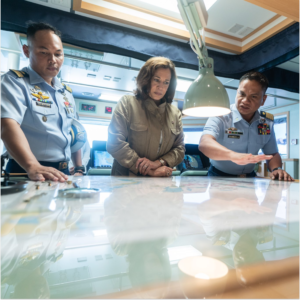16-year-old Samantha de Mesa is the winner of The Harbinger Prize 2024: International affairs

US vice president Kamala Harris on a Philippine coast guard patrol ship in Puerto Princesa, Palawan Island, Philippines, 2022.
December 19, 2024
Philippines calls for diplomacy amid tension over the long-running South China Sea dispute
The history of the Philippines continues to tell us a story of our fragmented yet significant past, which remains relevant in solving disputes in the contemporary era.
One of the longest-running and most complicated disputes is with China, over ownership of the West Philippine Sea and the various islands, reefs and waters within it.
The difference between the West Philippine Sea and the South China Sea remains confusing for some. The South China Sea is a section of the Pacific Ocean from Singapore and the Strait of Malacca in the south-west to the Strait of Taiwan in the north-east. The West Philippine Sea is just part of this much larger sea; it refers to the bodies of water on the western side of the Philippine archipelago that fall into the country’s exclusive economic zone (EEZ), which extends 200 nautical miles from the Philippine shore.
The first formal evidence of the Philippines’ ownership of the West Philippine Sea comes from the historic Velarde Map, published in Manila in 1734. The Carta Hydrographica y Chorographica de las Yslas Filipinas is a scientific map that helped determine the make-up of the Philippine archipelago.
It was made by Jesuit friar and cartographer Pedro Murillo Velarde, alongside engraver Nicolas de la Cruz Bagay and artist Francisco Suarez, who were Filipinos. The map includes the West Philippine Sea, Scarborough Shoal and the Spratly Islands.
In December 1947, China published a U-shaped dotted line, drawn by Chinese cartographer Yang Huairen, as a visual representation of the sea and land that China claims within the South China Sea. With this eleven-dash-line – now known as the nine-dash-line – Yang introduced 286 chunks of rock and reef, naming the territory collectively as the “South China Sea Islands”.
The West Philippine Sea, Scarborough Shoal and the Spratly Islands all fall within the nine-dash-line – so China claims it has sovereignty over them all.
Despite territorial disputes over the South China Sea tracing back to the late 1940s, the threats from China became more powerful and assertive during the mid-1990s with the Panganiban Reef incident and have escalated further since the Scarborough Shoal stand-off in 2012.
In 1995, the Philippine navy found evidence of Chinese forces building octagonal huts as shelters for their fishermen on Panganiban Reef (aka Mischief Reef) in the Spratly Islands. President Ramos – then president of the Philippines – sought a diplomatic settlement, which resulted in the Association of Southeast Asian Nations (ASEAN) Declaration on the South China Sea Code of Conduct.
This called for a peaceful resolution of disputes, the exercise of restraint by involved parties, and cooperation in areas of mutual interest. Despite the agreement, the Chinese continued the establishment of the huts unbeknownst to the Philippines until a year later.
Almost two decades later, in 2012, there was a major incident at Scarborough Shoal when Chinese surveillance vessels prevented the Philippine navy from arresting Chinese fishermen sailing across Scarborough Shoal. The coast guards and navies of both nations were involved in the stand-off amid China’s rigorous efforts to militarize the area.
The stand-off influenced the Philippine government to institute legal proceedings in the Permanent Court of Arbitration (PCA), an intergovernmental organisation under the United Nations Convention on the Law of the Sea. The PCA finally reached a verdict in July 2016.
The ruling found firmly in favour of the Philippines, declaring that China’s claims in the South China Sea do not include a “historic title”, and declared its employment of the nine-dash line, land reclamation activities and reciprocal occupation of the West Philippine Sea impermissible. China refused to recognise the ruling.
Since President Ferdinand ‘BongBong’ R. Marcos Jr. took office in June 2022, up to December 2023, the Philippines submitted more than 130 diplomatic protests in the long-running dispute, as China continued its blatant aggression towards Philippine-owned vessels.




